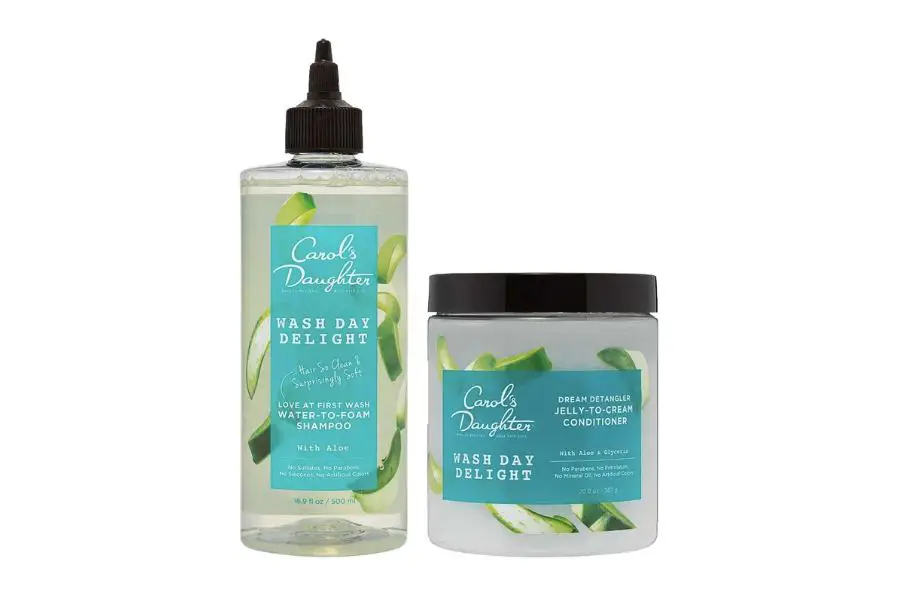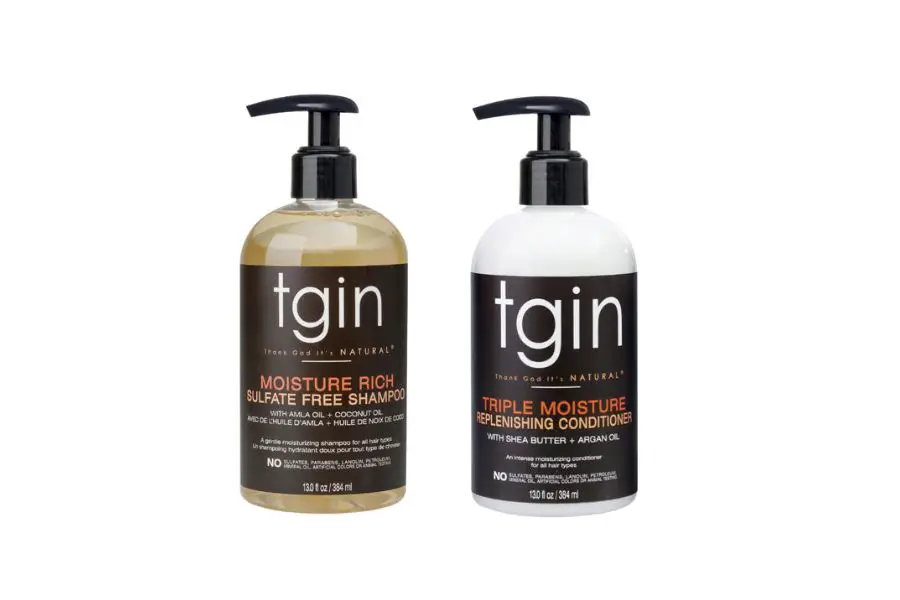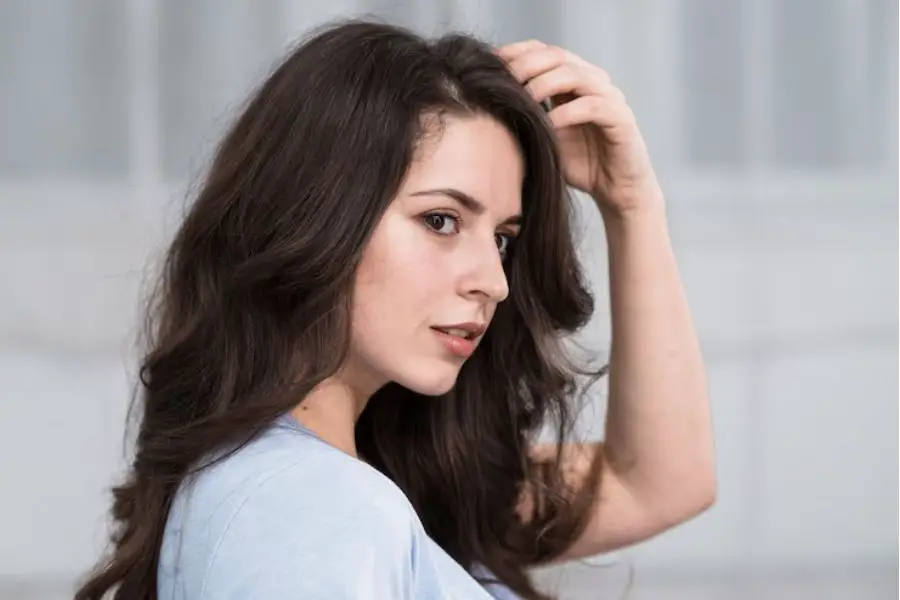Low porosity hair has tightly closed cuticles, making it resistant to moisture. Choosing the right shampoos for low-porosity hair can be overwhelming.
This article aims to guide you through the complexities of selecting the ideal shampoo. The best shampoo will enhance moisture absorption and hair health.
Join us as we explore the most effective ingredients and products available.
Best Shampoos for Low Porosity Hair
Finding the perfect shampoo for your low-porosity hair can be a game-changer. Below, you’ll discover our top picks to cleanse and nourish those stubborn strands.
Best for Greasy Hair
Thank God It’s Natural tgin Rose Water Sulfate-Free Hydrating Shampoo
Best Moisture Set
Best Organic
Best for Product Buildup
Best Cleansing

SheaMoisture Low Porosity Weightless Hydrating Shampoo
SheaMoisture Low Porosity Weightless Hydrating Shampoo provides gentle cleansing and balanced hydration. This shampoo is specifically formulated for low porosity and protein-sensitive hair types.
What we like
- Lightweight, hydrating formula
- Formulated with natural ingredients
- Sulfate-free, suitable for sensitive hair
This shampoo from SheaMoisture addresses the struggles of low porosity, protein-sensitive hair types. It blends grapeseed, tea tree, sunflower oil, and shea butter. The shampoo provides a gentle yet effective cleanse. It does this while keeping your hair hydrated without weighing it down.
This Cruelty-Free product shows SheaMoisture’s commitment to ethical and sustainable practices. All this while delivering high-quality hair care.

Thank God It’s Natural tgin Rose Water Sulfate-Free Hydrating Shampoo
Say hello to smooth, frizz-free curls with this TGIN Rose Water Sulfate-Free Hydrating Shampoo.
What we like
- Hydrates without weighing down hair
- Gentle cleansing and nourishing formula
- Infused with vitamin-rich rose water
This shampoo provides hydration and nourishment to your low-porosity hair. Still, it doesn’t make it feel greasy. The natural rose water infusion leaves your curls soft and looking more defined than ever.
The gentle cleansing not only helps maintain a healthy scalp. It also encourages hair growth. This makes it a great addition to your hair care routine.

Carol’s Daughter Wash Day Delight Shampoo & Conditioner Set
Give Carol’s Daughter Wash Day Delight Set a try for its innovative formulas and moisturizing properties.
What we like
- Unique water-to-foam shampoo with micellar technology
- Jelly-to-cream conditioner for tangle-free hair
- Sulfate-free, silicone-free, and paraben-free formula
The Carol’s Daughter Wash Day Delight Shampoo and Conditioner Set stands out for its unique formulas. The shampoo’s micellar technology transforms from water to foam texture. It cleanses your scalp and hair without stripping it.
This Shampoo also minimizes tangles and rinses clean. This removes any residue and makes it easier for you to manage your low-porosity hair on wash days.

Thank God It’s Natural Moisture Duo
The tgin Moisture Rich Shampoo and Conditioner Duo is a great choice for achieving healthy, moisturized hair.
What we like
- Thoroughly cleanses without stripping natural oils
- Boosts moisture retention with Pro Vitamin B5
- Suits various hair types, including dry, curly, and color-treated
The tgin Moisture Rich Sulfate Free Shampoo cleanses your hair without the use of harsh chemicals. It has coconut oil and Pro Vitamin B5 that help keep moisture for healthier hair. You’ll notice that your hair feels soft and smooth after just one wash.
Pairing the shampoo with the Triple Moisture Replenishing Conditioner creates the ultimate treatment. This is suitable for various hair types, even color-treated ones.

Shea Moisture Shampoo and Conditioner Set
This set provides hydration and nourishment without any harmful chemicals.
What we like
- Moisturizing with Manuka honey
- Nourishing Mafura oil
- Healthy hair growth support from Fig Extract, Baobab Oil, and Vitamin C
The Shea Moisture Shampoo and Conditioner Set features a powerful blend of key ingredients. These ingredients include Manuka honey, Mafura oil, and Fig Extract. They work together to provide your low-porosity hair with much-needed hydration and repair.
This shampoo has a beautiful scent and nourishing properties. It is free of parabens, phthalates, sulfates, and mineral oil, reassuring high quality.

Mielle Organics Pomegranate & Honey Shampoo
This shampoo provides a gentle cleanse with a delightful scent and moisturizing benefits.
What we like
- Natural and organic ingredients
- Gentle cleansing formula
- Tackles tough tangles effectively
You’ll love the natural and organic ingredients found in this shampoo. This hydrating curl cleanser not only smells incredible, but it also works to repair, restore, and prevent frizz in dry, damaged hair.

Alikay Naturals Moist Black Soap Shampoo
A game-changing shampoo that cleans and moisturizes at the same time.
What we like
- Formulated with raw black soap
- Sulfate-free
- Soothes the scalp while removing buildup
Unlike traditional shampoos, this product doesn’t lather up and still cleans your hair and scalp. Thanks to the raw black soap formula, it works wonders on low-porosity hair. It provides hydration and protection against dryness and itchiness.
The sulfate-free formula is gentle on your hair. This ensures that it doesn’t strip away the necessary oils and nutrients.

Noughty 97% Natural Detox Dynamo Clarifying Shampoo
Give this shampoo a try if you need a gentle, clarifying shampoo with natural ingredients to combat residue and build-up in your hair.
What we like
- Effectively removes build-up and residue
- 97% natural ingredients
- Suitable for regular use
Noughty’s Detox Dynamo Clarifying Shampoo is suitable for all hair types. Still, its formula is the best match for individuals with low-porosity hair. With 97% natural ingredients, you can expect a gentle yet effective cleanse for your hair and scalp.

Kinky Curly Come Clean Natural Moisturizing Shampoo
If you’re searching for a sulfate-free shampoo for low-porosity hair, Kinky Curly Come Clean is the perfect candidate.
What we like
- Effective at removing buildup
- Ideal for low-porosity hair
- Delightful Mandarin Orange scent
Kinky Curly Come Clean provides a gentle yet thorough cleanse without harsh chemicals. The Mandarin Orange extract works wonders in cleaning your hair and scalp of dulling buildup. It leaves you with refreshed curls.
Sea Kelp helps maintain the proper moisture balance in your hair. This makes this shampoo a great choice for those with dry and damaged hair.

Camille Rose Naturals Clean Rinse Shampoo, 8 OZ
This shampoo is a great choice if you’re looking for a gentle, refreshing, and nourishing option for low-porosity hair.
What we like
- Effectively clarifies and removes product build-up
- Hydrates and softens hair with natural oils
- Peppermint scent provides a refreshing scalp experience
Camille Rose Naturals Clean Rinse Shampoo provides a unique cleansing experience. It has a minty, aromatic scent and a pH-balanced formula. This shampoo delivers the ultimate cleansing and moisture benefits to your hair. This makes it an ideal choice for those with low-porosity hair.
What Is Low Porosity Hair?
Hair with low porosity is worse at absorbing moisture and oils. It tends to dry out at a slower pace while also taking longer to hydrate. This is because of the hair’s structure, as the cuticle layer is flat.
Three primary parts make up your hair:
- The cuticle
- The cortex
- The medulla
The outermost layer is the cuticle. In low-porosity hair, the cuticle is packed, creating a barrier that hinders the penetration of moisture.
Hair porosity refers to how well your hair can absorb and keep moisture. There are three types of hair porosity:
- Low
- Medium
- High porosity
High-porosity hair exhibits gaps and holes in the cuticle, enabling moisture to move in and out with ease.
Medium porosity hair falls in between the two extremes. It needs moderate care and attention to maintain proper moisture levels.
The Causes of Low Porosity Hair
Here are the most common causes of low porosity hair:
- Environmental factors
- Lack of damage
- Genetics
- Age and hormones
- Protein overload
How To Test for Low Porosity Hair
To determine your hair’s porosity, you can conduct a straightforward “float test” at home.
Begin by filling a glass with water and dropping one of your clean, shed hairs into it. Take a few minutes to observe how the hair behaves in the water.
If the hair floats to the surface, it suggests that you likely have low-porosity hair. If the hair sinks fast, it might indicate high-porosity hair.
Try out our hair porosity quiz to find your porosity now.
Characteristics of Low Porosity Hair

Here are the main low-porosity hair characteristics:
- Moisture-resistant hair type.
- Long drying time after washing.
- Prone to product buildup.
- Difficulty absorbing oil.
- Sensitive to protein treatments.
- Shiny but often frizzy and dull.
- Resistant to chemical treatments.
- Feels smooth but can be rough and dry.
- Less elastic hair.
- Prone to tangles and matting.
- Floats in water.
- Susceptible to split ends.
- Easily develops scalp product buildup.
How Do You Fix Low Porosity Hair?
Here are nine strategies you can employ to enhance the condition of your low-porosity hair:
- Select appropriate hair care items.
- Apply products on damp hair.
- Clean your hair on a regular basis.
- Hydrate your hair.
- Use heat during treatments.
- Pick pH-balanced products.
- Look for humectants.
- Apply products in sections.
- Trim hair on a regular basis.
Select Appropriate Hair Care Items
Choose products formulated for low-porosity hair, particularly those with lightweight, hydrating ingredients.
Apply Products on Damp Hair
Apply hair products while hair is still slightly wet to enhance absorption.
Cleanse Your Hair
Use a clarifying shampoo or rinse regularly to remove product buildup.
Ensure Proper Hydration
Regularly use deep conditioning treatments with natural humectants like aloe vera or honey.
Utilize Heat During Treatments
Use heat during conditioning treatments to open up cuticles and enhance product penetration.
Use pH Balanced Products
Select hair products with a pH of around 5-6 to promote shine and smoothness.
Use Humectants
Choose products with ingredients like glycerin that attract and bind water to the hair.
Apply Products in Sections
Divide hair into smaller sections when applying products to ensure even distribution.
Regularly Trim Your Hair
Trim hair every 8-12 weeks to eliminate split ends and prevent further damage.
What Ingredients To Avoid for Low Porosity Hair
Here are the ingredients to avoid for low-porosity hair:
- Sulfates
- Non-water soluble proteins
- Mineral oil and petrolatum
- Alcohols
- Formaldehyde
- Synthetic perfumes
- PPG, PEG, and EO Ingredients
1. Sulfates
These are harsh detergents that are often used in shampoos to create lather and remove dirt and oil.
They can strip the hair of its natural oils, leading to dryness and damage. Some common sulfates include sodium lauryl sulfate and sodium laureth sulfate.
2. Non-Water Soluble Proteins
These proteins can cause buildup on low-porosity hair, leading to a feeling of stiffness and dryness.
This is because they aren’t able to penetrate the hair shaft and instead stay on the surface.
3. Mineral Oil and Petrolatum
These are heavy oils that can create a film on the hair, preventing moisture from penetrating the hair shaft.
They are often used in hair care products for their cheap cost and smoothing properties.
4. Alcohols
Not all alcohols are equal. Short-chain alcohols like ethanol and isopropyl alcohol can be drying
Long-chain or fatty alcohols like cetyl alcohol and stearyl alcohol can be moisturizing.
5. Formaldehyde
This is a preservative that’s often used in hair care products. It’s a known carcinogen and can cause skin irritation and allergic reactions.
6. Synthetic Perfumes
These can cause irritation and allergic reactions in some people. They also don’t provide any benefits to the hair.
7. PPG, PEG, and EO Ingredients
These are often used in hair care products for their emulsifying properties. They can cause skin irritation and allergic reactions.
PEGs (polyethylene glycols) are often contaminated with 1,4-dioxane. This by-product has the potential to cause cancer.
What Ingredients To Look for in Low Porosity Hair Shampoo
The ingredients in your shampoo for low-porosity hair should lift the cuticle and infuse the hair with moisture. Here are some key ingredients to look for:
- Gentle surfactants
- Hydrating agents
- Light oils
- Clarifying agents
- Hydrolyzed proteins
- Behentrimonium Methosulfate
- Cetrimonium Chloride
- Green tea
- Honey
- Witch hazel
| Ingredient | Description |
|---|---|
| Gentle Surfactants (decyl glucoside, coco glucoside, sodium lauroyl lactylate) | Cleanses hair without stripping natural oils like traditional sulfates. |
| Hydrating Agents (glycerin, aloe vera, panthenol) | Draws moisture into the hair strand. |
| Light Oils (argan oil, jojoba oil, grapeseed oil) | Provides moisture without weighing down hair. |
| Clarifying Agents (tea tree oil, peppermint oil) | Removes product build-up from hair. |
| Hydrolyzed Proteins | Small enough to penetrate the hair shaft. Use less to prevent protein overload. |
| Behentrimonium Methosulfate | A gentle conditioning agent that helps detangle and soften hair without causing build-up. |
| Cetrimonium Chloride | Smooths the hair cuticle, facilitating penetration of moisture and nutrients into the hair shaft. |
| Green Tea | Provides moisture without weighing down the hair. |
| Honey | A natural humectant that draws moisture into your hair. |
| Citric Acid | Used to adjust the pH of a shampoo, promoting shine and manageability. |
| Witch Hazel | An astringent plant extract that removes excess oil and buildup without stripping the hair. |
What Type of Shampoo Is Best for Low Porosity Hair?
The best type of shampoo for this hair type would be a clarifying or chelating shampoo. These can help remove product buildup and open up the cuticles to absorb moisture better. Here’s what you should look for:
- Clarifying shampoos
- Sulfate-free shampoos
- Moisturizing shampoos
- Protein-free shampoos
1. Clarifying Shampoos
These shampoos remove product buildup, oils, and dirt from the hair. They help open up the cuticles on low-porosity hair. This makes it easier for moisture to penetrate.
Clarifying shampoos can be quite drying if used too often. It’s best to use them once a week or less, depending on how much buildup you have.
2. Chelating Shampoos
If you have hard water, a chelating shampoo might be a good choice.
These shampoos remove mineral buildup from the hair. This can make it easier for moisture to penetrate.
3. Sulfate-free Shampoos
Sulfates are harsh detergents that can strip the hair of its natural oils.
Sulfate-free shampoos are a gentler option that can clean the hair without drying it out.
4. Moisturizing Shampoos
Look for shampoos that contain hydrating ingredients like aloe vera, glycerin, or panthenol.
5. Protein-free Shampoos
Low porosity hair is often protein-sensitive. This means it can become stiff and dry if too much protein builds up on the hair.
Look for shampoos that are protein-free or have protein listed low on the ingredients list.
Frequently Asked Questions
Does low-porosity hair need shampoo?
Yes, low-porosity hair needs shampoo, just like any other hair type. Shampoo helps remove dirt, oil, and buildup from your scalp and hair strands. Choose a shampoo designed for low-porosity hair. Some shampoos can be too heavy or not provide the necessary moisture your hair needs.
What is the best way to wash low-porosity hair?
To wash low-porosity hair, wet your hair with warm water to open up the hair cuticles. Apply a shampoo designed for low-porosity hair. Massage it into your scalp and hair strands. Rinse the shampoo out with warm water. Apply a conditioner, concentrating on the ends and applying it to the roots. Allow the conditioner to sit for a few minutes. Rinse the conditioner out with cool water to help seal the hair cuticles and lock in the moisture.
Is it okay to wash low-porosity hair every day?
No, washing low-porosity hair every day is not recommended. Frequent washing strips away the natural oils needed to keep your hair moisturized. This leads to dryness and breakage. Instead, try to wash your low-porosity hair every 3-5 days.








